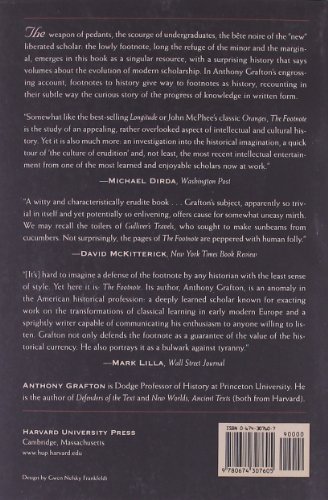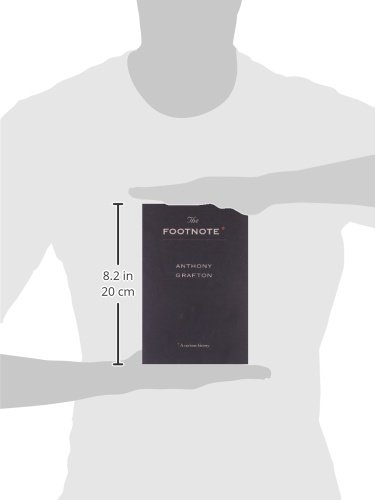



The Footnote: A Curious History
H**Y
witty, whimsical tour of the methodsof historical learning
The history, use and meaning of the footnote is a rather unlikely subject for a book, however, Grafton uses it to focus on the practice of history and the flesh-and-blood jealousies, mistakes and falsehoods which lie behind even the driest of academic pursuits.One caveat, which struck me at the start, is that surely footnotes would not have evolved solely form historical research, surely they would have surfaced in more useful contemporary documents, perhaps to do with legal or diplomatic professions. That apart, Grafton takes the evolution of the footnote in historical scholarship as the evolution of `scientific' methodology in historical research. On the surface Grafton states that the `the text persuades, the notes prove'. Originally history was story telling by people who claimed to be present, and/or participants, in great events. As scholarship evolved, the fact that participants might have different motivations, points-of-view and/or explicit biases became increasingly apparent. "Ambassadors' reports - a great source of archival works - report on deliberations to which they did not have direct access and the intentions of monarchs who did not speak frankly". Therefore scholars began to quote their sources by use of footnotes to the main text. Within this context, Grafton illustrates the distance some scholars will go to, in terms of selective quotation of some sources, the suppression of others and it is this which enlivens a topic which otherwise might have been deathly-dull. He acknowledges, with admiration, that some historians use footnotes to allow that there exist contrary interpretations of the thesis they are pursuing. However his work in the field allows him to allow him to add venom e.g. ` but often they (historians) quietly set the subtle, but deadly cf. (compare) in the footnote. This indicates, at least to the expert reader, both that an alternative view appears in the cited work and that it is wrong'. Grafton has worked in many European languages and this allows him to humorously include and compare the many differing ways that footnotes can convey bile - " The English do so with a characteristically sly adverbial construction `oddly overestimated'. Germans use the direct `ganz abwegig' (totally off-track); the French, a colder, but less blatant `discutable'". The book traces the evolution of the `scientific' recording and interpretation of texts to convey historical scholarship through the work of historians of three centuries, and it is though this that Grafton exhibits great learning and humanity. The foibles, ambitions and disputes are clearly acknowledged as is their passion for their work. Grafton has clear sympathy for both. He is more grudging in acknowledging the contribution of philosophy - specially the work of Descartes and Voltaire - in the development of the uneasy concoction of art and science which is modern history.This is a magnificent description of an exchange between Liebnitz and Bayle in the 1690's, where the latter's desire to document every mistake in historical writings available at the time, is called into question. Liebnitz instead argued that it would be more accurate and economical to pursue a project which documented the verified truth of historical research. Each project is, of course, infinite, though Liebnitz's is the more practicable. While Grafton ranges widely though the historians of the 14th to the 19th CenturyI feel that he reserves especially favour for Gibbon and von Ranke, Gibbon for his masterful confidence and literate authority - Grafton goes so far as to suggest that Gibbon reluctantly adopted the footnote, feeling that it broke the narrative flow. He favours Ranke for his zeal in perfecting the methodology of source quotation and interpretation as well as instituting the seminar for exposition and training of upcoming historians. Grafton points out, tellingly but humanely, that Ranke was not above self-delusion in his judgment of his own methodology, by showing that Ranke's own footnotes were less exact than the historian claimed. The narrative,which can be quite detailed and wide-ranging, flows along thanks to Grafton;s style. Complex points are not simplified, but nor are the human details overlooked e.g. his laconic opinion of the medieval Letters of Aristeas is rendered as ` this fascinating book has the defect of being a forgery, but also the compensating virtues of beauty and clarity'.
J**T
A must have
If your new to the use of foot notes this is a must have book
B**R
Very Good
Very Good
L**R
Footnotes Can Be Fun!
Anthony Grafton's short history of this often-irritating contrivance is a delightful defense of the footnotes importance. In an age that has become increasingly lazy in intellectual matters, and the call of some for the removal of all such arcana, Professor Grafton makes us deeply aware of the footnotes place in the study of history, and its continued importance as a major implement in the historian's toolbox. Taking us first to the supposed birth of the footnote with the Enlightenment and the immortal Gibbon, he moves on to Ranke and "Scientific History", then backtracks to the Middle Ages and Renaissance to reveal its true origins. Any lover of the history of the book, or history in general, cannot fail to enjoy it.
M**S
Interesting topic - boring book.
This book was a disappointment to me. The development of the use of footnotes in the study of history is an interesting enough subject. However, the book was tedious to read.There were some bits of wry humor in a few places, but considering the subject, there could have been much more.The author assumes the reader has a very detailed knowledge of the academic pursuit of historical studies and that the reader shares the same love/hate relationship with the footnote as generations of historians have consummated.Perhaps the book reads better in its original German. At any rate, I would pass on this one.
K**H
Narrowly-Focused, but Intelligent, Informative, and Provocative
This is an overview of the history of the practice of source citation, especially but not exclusively footnoting, in serious writings on Western history (from the classical, Renaissance/antiquarian, modern, and contemporary periods, and with a particular emphasis on Germany). The author discusses the attitudes toward source materials, the research and historiographcal practices, and the methods of sourcing and proving historical claims, of major historians through the ages, and of their effect on the practices of historical and general scholarship. In addition to being a history of sourcing practices, the book provides detailed and fascinating profiles of influential writers such as Suetonius, Gibbon, Hume, Ranke, and others, and of important movements in the practice of history, including Italian diplomatic histories, the Berlin "seminar" tradition, and the typographical innovations of various writers, whose professional and scholarly conflicts evolved a variety of citation practices suited to their intentions and context. The result is an engaging look at a complex past, evocative of heady and hard-fought battles for truth, status, and influence.The book focuses exclusively on historical writing; I get the impression that the author, an academic historian, tried to reach a wider audience by pitching it as a history of scholarship in general without broadening the focus of the research, which is a grave error. And at times the author seems to forget that the subject is footnoting specifically, and not historiography generally (to say nothing of scholarship across the board). But if you simply recast the title in your mind to something like "Historiography and Source Materials", it becomes a very effective treatment of its actual subject. (Possibly not comforting if that's not the subject you wanted to read about, but on its own terms it's a good piece of work.) The author touches glancingly on other fields, but it's true he does not cover them adequately. For readers without a deep interest in the minutiae of professional-level historiography, the book can be heavy going, but still rewarding.The writing is quite readable and often witty, though somewhat dense. At times it seems to garble the chronology of its subject, and in places it assumes the reader is more familiar with historiographic practices and figures than is appropriate for the general audience. But it is really not hard to follow, the material is rich, and the discussion is intelligent and interesting. (The author's theme of the "double argument" constituted by footnotes in conjunction with discursive text is insightful and provocative. His recognition that all scholarly writing serves some sort of agenda, and that footnotes are both tools in, and clues to, that practice, is a valuable analytical insight.) The subject is not exactly entertaining, but the author does a good job with it. (One pleasure in reading the book is identifying the off-hand quotes from popular culture that the author works in as sly jokes.)The book is not without flaws. But it is an effective and engaging treatment of its (actual, not ostensible) subject, accessible to both academic and educated general readers. As a treatment of scholarly practice it is useful though not comprehensive; as a history of historiographic practice regarding source citations, it is very valuable; as a meditation on the uses and methods of scholarly discourse it is remarkably thought-provoking. Somewhat specialized, and not for everyone, but a good read nonetheless.
K**R
Mostly renaissance stuff
I bought this book for a specialised purpose, so I probably didn't give the book a fair shake. Grafton writes engagingly, but, if you have read any of his books, you will know how he writes. This one is no different. It's mainly about the renaissance period and afterwards. Some of the references are to tertiary works, rather than primary sources, NB.
P**E
Footnotes: Every students biggest pain
The immense detail that Anthony Grafton goes into can be very off-putting for the casual reader, who is likely to be slowed down by his constant use of academic terminology. Grafton's method of storytelling is also slightly confused. It leaps around from example to example, covering centuries in a few lines without any clear indication of his argumentative route. It takes a while for Grafton to stop discussing the history of primary source research and to start analysing footnotes.However, the points he raises are hugely informative. His examples from the entire spectrum of historical study do give the book a very good depth. He focuses on a few key names where necessary, like Ranke and Gibbon, to show the contributions of people who have had an enormous affect on the history of the footnote. The book does give a very good insight into the history of the footnote.
Trustpilot
1 month ago
2 months ago